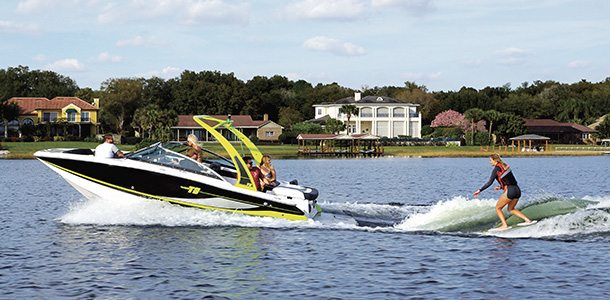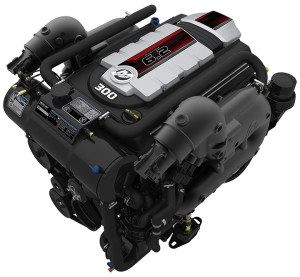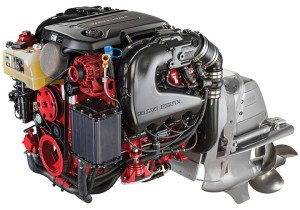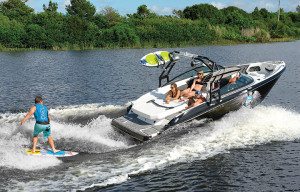New player, technology aim at reinvigorating sterndrive segment

From the two largest players taking very different approaches to developing new engines to a new manufacturer emerging in the market, the once predictable sterndrive engine segment has suddenly gotten a lot more interesting.
In the last two years alone, Mercury has launched its purpose-built sterndrive, while Volvo Penta has introduced its Forward Drive, as well as its next generation of sterndrives, built on the GM platform.
And at this year’s Miami International Boat Show in February, inboard engine manufacturer Ilmor announced its entry into the market.
A new player

Ilmor debuted its “One Drive” at the show, available in single- and twin-drive configurations. Powering the sterndrive package are the GM-Marine based Ilmor MV8 6.0L OPS (380 HP) and 6.2L OPS (430HP) engines, offered with electronic throttle and closed cooling systems as standard. The Ilmor One Drive utilizes sterndrive components provided by Yanmar Marine, already in operation with its diesel sterndrive systems.
On twin engine boats, Ilmor offers an optional “One Touch” joystick system. The system includes Ilmor’s MERLIN engine monitoring display and can be equipped with auto-pilot compatibility.
Despite the decline in sterndrive sales over the last decade, Ilmor sees the segment as one poised for a recovery, said company president Paul Ray.
“We are an engineering company at heart,” he said. “As engineers we sit down and think about how would you want to design a boat for the best effect, and sterndrive still makes enormous sense.”
Sterndrives make for a vessel with cleaner lines and more aesthetic appeal, Ray said.
“For us, we invested a lot of money in the development of this because of our belief that sterndrive is going to come back because all of the reasons that sterndrive was developed in the first place still exist today,” he said. “It’s more about the aesthetic than it is about just creating a fiberglass hull and throwing some engines on the back and saying we’re good.”
Ilmor has been working on various sterndrive projects for several years, and built the first of what would become the One Drive about 18 months ago. The company even looked at the outboard market but decided not to enter that segment for a variety of reasons.
“We fully recognize that outboards are going through a renaissance,” Ray said. “Certainly outboards have progressed enormously over time. That’s what we’re doing here. We’re trying to progress the sterndrive.”
At Miami, the engine was demonstrated on the Formula 350 CBR FX and is now available for purchase on Formula boats. Ilmor is working with several other OEMs as well.
The Ilmor team believes there is a space in the market for a more “refined” sterndrive product that will appeal to a higher-end customer.
The One Drive propulsion system features an electro-magnetically actuated hydraulic clutch transmission, the source of Ilmor’s “smooth shift” experience. The hydraulic clutch system quietly engages and disengages gears at two-shifts-per-second, according to the company.
“One of the reasons that we chose this drive to make work with our system is its hydraulic shifting,” Ray said. “It’s silky smooth and you wouldn’t want to go down the cone clutch road with the harshness you get with the typical cone clutch drive, particularly when you’re in joystick mode. You want it to be as smooth as possible.”
The twin propeller drive unit is built with precision forged gears for increased durability and is hard anodized for superior corrosion protection. All drive systems are complete with power assisted steering and hydraulic trim. The One Drive transom has a larger exhaust output than comparable systems, minimizing backpressure for improved engine performance, according to Ilmor.

“When someone buys a $300,000+ boat … they expect it to sound as refined as a Bentley they would get for the same price, and that’s what we’ve tried to achieve, something akin to the value that they’ve purchased,” Ray said.
The new engine will be “marginally” more expensive than comparable models from Mercury or Volvo Penta, but Ilmor believes customers will be willing to pay more for a better product.
“It’s been the foundation of our company, taking something that works and making it better, changing the expectations of what that product should be, to something that ultimately is advancing the boating industry,” said Jessica Gamarra, Ilmor’s director, sales and marketing.
The company worked extensively with Formula and other boat builders to craft the One Drive.
“These engines and drive were not built in a vacuum,” Gamarra said. “We spent a lot of time with them, understanding the challenges they’re facing with their current drive. What suggestions they had to improve the product, what they’d like to see.”
Formula has been “thrilled” to partner with Ilmor on the launch, said Scott Porter, president of Formula Boats.
“Our decision to carry the new One Drive systems was greatly influenced after Ilmor delivered over 10,000 reliable engines in water sports boats,” Porter said. “We have paired the robust, saltwater resistant 430 HP One Drive in a twin application in a Formula 350 CBR, which is performing fantastically well and exceeding expectations. With super smooth hydraulic shifting, the One Touch joystick docking system is the icing on the cake.”
A “steady resurgence” of sterndrives will benefit the entire industry, Ray said.
“There’s plenty of room for outboards, sterndrives, inboards to all live in the same space because they serve different customers,” he said. “We’re not trying to be the biggest engine company in the world. We want to enjoy the space that we’re in and be known as a company that produces something that is just a little bit better.”
Growth strategy
Both Mercury and Volvo Penta have also released several new products and accessories in the last year for the sterndrive market.
But even as those products have come out, both manufacturers are also spending a good deal of time and effort talking about a broader strategy that goes beyond focusing on products.

“Even if you produce one great product after another, you can still be behind unless you have a great ecosystem around it,” said David Foulkes, chief technology officer at Brunswick Corp., in introducing several new products from Mercury at this year’s Miami show.
Foulkes explained Mercury’s three-step strategy, consisting of building class-leading core products and integrated prop-to-helm solutions to create a “compelling, consumer-centric, connected ecosystem.”
With products like Active Trim, Vessel View, joystick control and more, boating can be easier and more enjoyable, Foulkes said.
(Read more about Mercury’s Miami announcements at BoatingIndustry.com/mercury2016.)
It’s Mercury’s decision to build it’s own purpose-built marine engines, starting with the 4.5-liter V6 in 2014, that makes it possible to invest in that type of technology, said Martin Bass, vice president of global category management at Mercury.
“We now control our destiny. We don’t need to worry about when an automotive company is going to change their strategy and what investment that’s going to force us [to make],” he said. “Rather, we can take our future product investments and put it toward things that are truly advantageous to the consumer. That’s the kind of technology we can go invest in because we’ve taken control of our own destiny in the base engine design and you’ll see a lot more of that from us.”
Volvo Penta is also emphasizing its “Easy Boating” initiative, with the belief that the best way to grow boating is to make it easy for new and current boaters to enjoy the lifestyle.
Products like IPS, DuoProp, joystick control, Glass Cockpit and last year’s introduction of Forward Drive all further that mission, said Ron Huibers, president of Volvo Penta of the Americas.

“Integration is the way that we deliver easy boating.” Huibers said. “Today’s boaters expect a trouble-free experience on the water, and we deliver this through our fully integrated helm-to-prop solution developed and supported by a single supplier.”
That focus has helped Volvo Penta of the Americas grow its total marine sales in North and South America by 12.5 percent in 2015.
“We are particularly pleased that our North America marine gas and marine leisure diesel growth was even greater thanks to our dealer support, leading builders and new innovative products,” Huibers said.
The Forward Drive, introduced at the 2015 Miami International Boat Show, has helped Volvo Penta advance that vision, by appealing to a larger base of potential boaters.
“Our introduction of the Forward Drive in 2015 is enabling the creation of an entirely new class of boats optimized for wake surfing and water sports as well as cruising, fishing and general fun on the water,” Huibers said. “We are seeing a number of these new sterndrive-FWD powered boats in dealer showrooms this year from more than a half-dozen builders.”
The industry has only scratched the surface of what wakesurfing can mean for boating, Huibers said.
“I think that wakesurfing is the best thing to happen to boating, even better than water skiing,” he said. “Go ask the general population if they know what water skiing is. Let’s say it’s 90 percent. But if you ask them what wakesurfing is — I used to say it was one out of 10, but it’s probably even less. My point is that when the population at large knows what wakesurfing is at the same ratio as water skiing, there’s nothing but upside for all of us in the boating industry.”
Two different paths
Both Mercury and Volvo Penta have launched new sterndrives in the last year as well, albeit following different strategies.
Mercury introduced new 6.2-liter, V-8 300hp and 350hp purpose-built sterndrives last summer. Like the V6 introduced in 2014, the engine was built and designed specifically for marine use.
“With respect to the product, we’ve had a lot of positive feedback from OEMs and consumers on the path that we’ve taken,” Bass said. “We have made a lot of improvements to the sterndrive engine as we rolled out this new product line. We do believe that it has to have a positive impact on demand because it is a superior product in so many ways.”
Mercury’s path offers more control and flexibility for the company, Bass said.

“We see where the automotive regulations are going, so even if we think the current product works, [and] we can buy from an automotive company and make it work, we don’t know what the future product looks like and it’s not going in the right direction for a marine application,” he said. “The investment we made in our product portfolio was quite a bit larger than we would have made just to simply marinize the next generation of automotive engines. That alone should tell you that we feel very strongly about our strategy.”
 On the other hand, Volvo Penta believes that continuing to work with GM offers the best solution for the industry.
On the other hand, Volvo Penta believes that continuing to work with GM offers the best solution for the industry.
“Our long-standing relationship with GM gives us access to the latest advances in automotive engine technology and economies of scale that cannot be achieved in a low-volume custom manufacturing operation,” Huibers said. “GM builds about 4,500 Gen V blocks per day, and has fielded more than 1.7 million units. These engines are proven performers. The technologies built into the Gen V engines have never been available in any marine gas engine.”
That technology forms the foundation of Volvo Penta’s next-generation V8, released at IBEX 2015.
“Based on the revolutionary GM Gen V platform, the new Volvo Penta gas engines leverage the latest new advances in automotive technology: all-aluminum block, exhaust manifolds and heads; variable valve timing; direct fuel injection, wideband O2 sensors; and standard fresh-water cooling,” Huibers said. “These add up to a major leap in performance, fuel economy and emissions. Boaters who have experienced the new engines have commented on their impressive acceleration across the full range of RPMs.”
New technology and innovation are the keys to growth in not only the sterndrive segment, but the entire industry, Huibers said.
“There have been changes in water sports and boating styles, and until now there has been little in the way of new innovations in marine sterndrive technology,” he said. “That is why we continue to invest to bring new technology to the marketplace, including our next generation of the most power dense engines yet combined with our new Forward Drive to give boaters more versatility. We continue to invest and will bring out more new innovative products over the coming years.”
Mercury’s Bass echoed that dedication to product development, noting Mercury’s recent investments in new products.
“We have a very realistic view of the sterndrive market going forward, but that realistic view includes the fact that sterndrive is going to be a very important part of our product line and our future,” Bass said. “We know there are [fewer] sterndrive customers today than there were 10 years ago by a wide margin, but there are sterndrive customers out there. The sterndrive customers that are out there are premium customers, so the uptake on some of our advanced control systems, like joystick, has grown even though the market has shrunk. We think the value proposition for sterndrive will continue to be appealing to that particular customer.”




